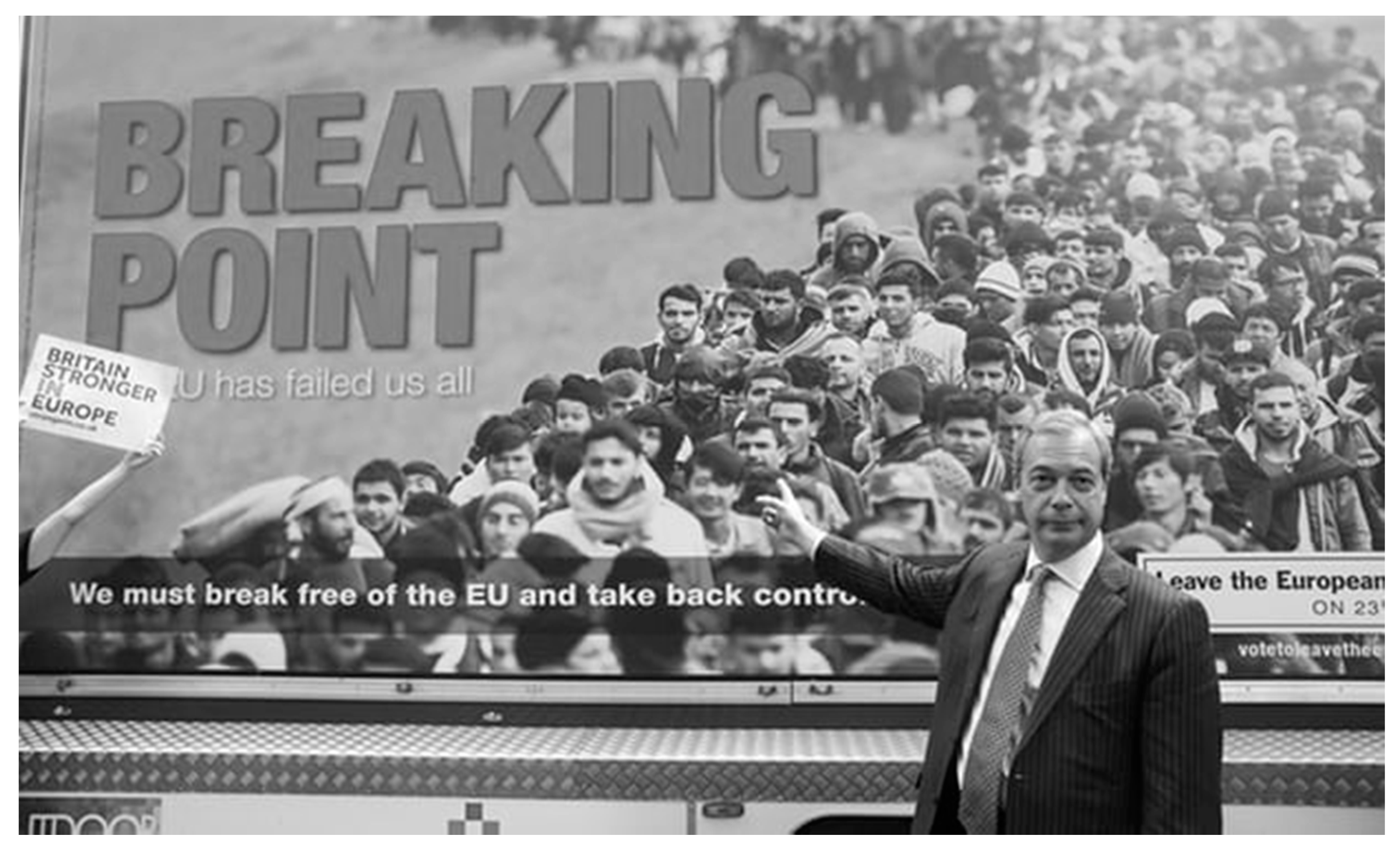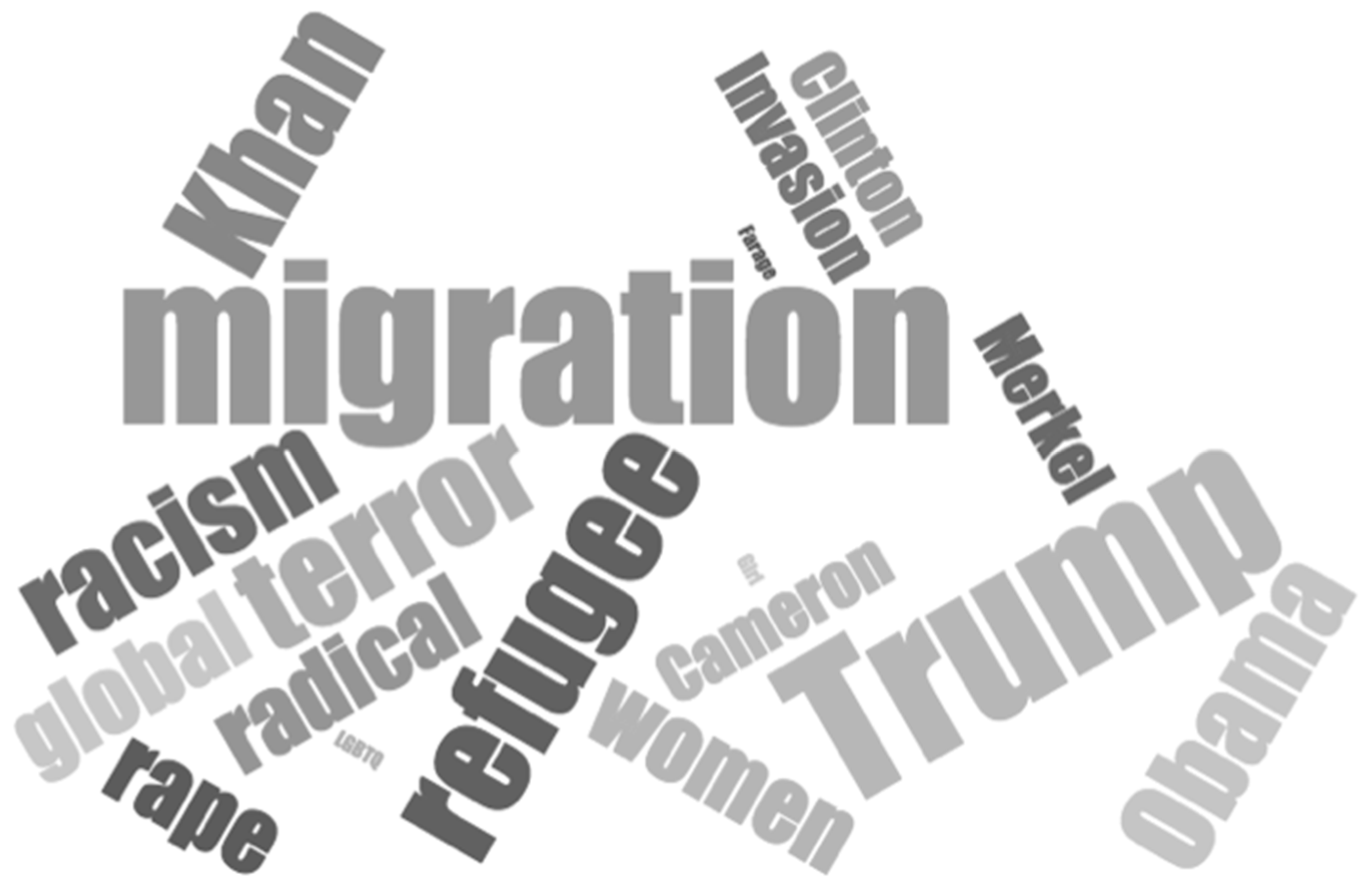Hate in a Tweet: Exploring Internet-Based Islamophobic Discourses
Abstract
1. Introduction
2. Islamophobia: Definitions and Implications
- Monolithic: Islam is seen as a monolithic entity that does not change in encountering new realities
- Separate: Islam is considered as separate from and having nothing in common with other cultures
- Inferior: Islam is deemed as inferior to the West, irrational, barbaric, primitive, and sexist
- Enemy: Islam is portrayed as violent, aggressive, threatening, and engaging in a “clash of civilization”
- Manipulative: Islam is considered as a political ideology, not a sincere religious belief
- Criticism of the West rejected: Muslim criticism of the West are rejected out of hand
- Discrimination defended: Discriminatory practices against Muslims are justified and Muslims are excluded from mainstream society
- Islamophobiaseen as natural: Islamophobia is accepted as something natural and normal.
Online Islamophobia can be defined as Islamophobic prejudice that targets a victim in order to provoke, cause hostility and promote intolerance by means of harassment, stalking, abuse, incitement, threatening behavior, bullying and intimidating of the person or persons, via all platforms of social media. (p. 6)
3. Brexit and Twitter Islamophobia
4. Studying Twitter: Methods
5. Analysis of Islamophobic Tweets
5.1. Internet-Based Views of Islam
5.2. Specific Characteristics of Internet-Based Islamophobia
6. Discussing Online Islamophobia
7. Conclusions
Funding
Conflicts of Interest
References
- Allen, Chris. 2014. Britain First: The ‘Frontline Resistance’ to the Islamification of Britain. The Political Quarterly 85: 354–61. [Google Scholar] [CrossRef]
- Allen, Chris. 2015. ‘People Hate You Because of the Way You Dress’: Understanding the Invisible Experiences of Veiled British Muslim Women Victims of Islamophobia. International Review of Victimology 21: 287–301. [Google Scholar] [CrossRef]
- Awan, Imran. 2014. Islamophobia and Twitter: A Typology of Online Hate against Muslims on Social Media. Policy & Internet 6: 133–50. [Google Scholar] [CrossRef]
- Awan, Imran, and Irene Zempi. 2015. We Fear for Our Lives: Online and Offline Experiences of Anti-Muslim Hate Crime. London: Tell Mama. Available online: http://irep.ntu.ac.uk/id/eprint/25975/ (accessed on 5 August 2018).
- Bakali, Naved. 2016. Islamophobia: Understanding Anti-Muslim Racism through the Lived Experiences of Muslim Youth. Rotterdam: Sense Publishers. [Google Scholar]
- Beydoun, Khaled A. 2018. American Islamophobia: Understanding the Roots and Rise of Fear, 1st ed.Oakland: University of California Press. [Google Scholar]
- Brown, Alexander. 2018. What Is so Special about Online (as Compared to Offline) Hate Speech? Ethnicities 18: 297–326. [Google Scholar] [CrossRef]
- Conover, Michael D., Bruno Gonçalves, Alessandro Flammini, and Filippo Menczer. 2012. Partisan Asymmetries in Online Political Activity. EPJ Data Science 1. [Google Scholar] [CrossRef]
- Dostal, Jörg Michael. 2015. The Pegida Movement and German Political Culture: Is Right-Wing Populism Here to Stay? The Political Quarterly 86: 523–31. [Google Scholar] [CrossRef]
- Douglas, Christopher. 2018. Religion and Fake News: Faith-Based Alternative Information Ecosystems in the US and Europe. The Review of Faith & International Affairs 16: 61–73. [Google Scholar] [CrossRef]
- Ekman, Mattias. 2015. Online Islamophobia and the Politics of Fear: Manufacturing the Green Scare. Ethnic and Racial Studies 38: 1986–2002. [Google Scholar] [CrossRef]
- Elahi, Farah, and Omar Khan. 2017. Islamophobia: Still a Challenge for Us All. Runnymede Trust Publications and Resources. Available online: https://www.runnymedetrust.org/uploads/Islamophobia%20Report%202018%20FINAL.pdf (accessed on 11 September 2018).
- Esposito, John L., and Ibrahim Kalin, eds. 2011. Islamophobia: The Challenge of Pluralism in the 21st Century, 1st ed. Oxford and New York: Oxford University Press. [Google Scholar]
- Evolvi, Giulia. 2017. #Islamexit: Inter-Group Antagonism on Twitter. Information, Communication & Society, 1–16. [Google Scholar] [CrossRef]
- Evolvi, Giulia. 2018. Blogging My Religion: Secular, Muslim, and Catholic Media Spaces in Europe, 1st ed.Abingdon: Routledge. [Google Scholar]
- Farida, Vis, Liesbet van Zoonen, and Sabina Mihelj. 2011. Women Responding to the Anti-Islam Film ‘Fitna’: Voices and Acts of Citizenship on YouTube. Feminist Review 97: 110–29. [Google Scholar]
- Gardner, Rod, Yasemin Karakaşoğlus, and Sigrid Luchtenberg. 2008. Islamophobia in the Media: A Response from Multicultural Education. Intercultural Education 19: 119–36. [Google Scholar] [CrossRef]
- Garner, Steve, and Saher Selod. 2015. The Racialization of Muslims: Empirical Studies of Islamophobia. Critical Sociology 41: 9–19. [Google Scholar] [CrossRef]
- Golf-Papez, Maja, and Ekant Veer. 2017. Don’t Feed the Trolling: Rethinking How Online Trolling Is Being Defined and Combated. Journal of Marketing Management 33: 1336–54. [Google Scholar] [CrossRef]
- Grosfoguel, Ramon. 2017. The Multiple Faces of Islamophobia. Islamophobia Research & Documentation Project (Blog), May 8. Available online: https://irdproject.com/the-multiple-faces-of-islamophobia/ (accessed on 1 October 2018).
- Hopkins, Nick, and Vered Kahani-Hopkins. 2006. Minority Group Members’ Theories of Intergroup Contact: A Case Study of British Muslims’ Conceptualizations of Islamophobia and Social Change. British Journal of Social Psychology 45: 245–64. [Google Scholar] [CrossRef] [PubMed]
- Howard, Philip N., and Bence Kollanyi. 2016. Bots, #StrongerIn, and #Brexit: Computational Propaganda during the UK-EU Referendum. arXiv, arXiv:1606.06356. [Google Scholar]
- Hussain, Serena, and Jamil Sherif. 2014. Minority Religions in the Census: The Case of British Muslims. Religion 44: 414–33. [Google Scholar] [CrossRef]
- Hussain, Yasmin, and Paul Bagguley. 2012. Securitized Citizens: Islamophobia, Racism and the 7/7 London Bombings. The Sociological Review 60: 715–34. [Google Scholar] [CrossRef]
- Jackson, Daniel, Einar Thorsen, and Dominic Wring. 2016. EU Referendum Analysis 2016: Media, Voters and the Campaign. Early Reflections from Leading UK Academics. Available online: http://www.referendumanalysis.eu/ (accessed on 26 June 2018).
- Jones, Steve. 2015. How I Learned to Stop Worrying and Love the Bots. Social Media + Society 1. [Google Scholar] [CrossRef]
- Linehan, Thomas. 2012. Comparing Antisemitism, Islamophobia, and Asylophobia: The British Case. Studies in Ethnicity and Nationalism 12: 366–86. [Google Scholar] [CrossRef]
- Magdy, Walid, Kareem Darwish, and Norah Abokhodair. 2015. Quantifying Public Response towards Islam on Twitter after Paris Attacks. arXiv, arXiv:1512.04570. [Google Scholar]
- Maltby, John, Liz Day, Ruth M. Hatcher, Sarah Tazzyman, Heather D. Flowe, Emma J. Palmer, Caren A. Frosch, Michelle O’Reilly, Ceri Jones, Chloe Buckley, and et al. 2016. Implicit Theories of Online Trolling: Evidence That Attention-Seeking Conceptions Are Associated with Increased Psychological Resilience. British Journal of Psychology 107: 448–66. [Google Scholar] [CrossRef] [PubMed]
- Meer, Nasar, and Tehseen Noorani. 2008. A Sociological Comparison of Anti-Semitism and Anti-Muslim Sentiment in Britain1. The Sociological Review 56: 195–219. [Google Scholar] [CrossRef]
- Miller, Carl, Francesca Arcostanzo, Josh Smith, Alex Krasodomski-Jones, Susann Wiedlitzka, Rooham Jamali, and Jack Dale. 2016. From Brussels to Brexit/Islamophobia, Xenophobia, Racism and Reports of Hateful Incidents on Twitter. Channel 4 Dispatches–‘Racist Britain.’ Center for the Analysis of Social Media, Demos. Available online: https://francescaarcostanzo.wordpress.com/publications/ (accessed on 2 July 2018).
- Mondon, Aurelien, and Aaron Winter. 2017. Articulations of Islamophobia: From the Extreme to the Mainstream? Ethnic and Racial Studies 40: 2151–79. [Google Scholar] [CrossRef]
- Pennington, Rosemary. 2018. Making Space in Social Media: #MuslimWomensDay in Twitter. Journal of Communication Inquiry 42: 199–217. [Google Scholar] [CrossRef]
- Philander, Kahlil, and YunYing Zhong. 2016. Twitter Sentiment Analysis: Capturing Sentiment from Integrated Resort Tweets. International Journal of Hospitality Management 55: 16–24. [Google Scholar] [CrossRef]
- Poole, Elizabeth, and John E. Richardson. 2006. Muslims and the News Media. London: I.B.Tauris. [Google Scholar]
- Runnymede Trust. 1997. Islamophobia: A Challenge for Us All. Runnymede Trust Publications and Resources. Available online: https://www.runnymedetrust.org/companies/17/74/Islamophobia-A-Challenge-for-Us-All.html (accessed on 21 June 2018).
- Said, Edward W. 1979. Orientalism, 1st ed.New York: Vintage. [Google Scholar]
- Sanfilippo, Madelyn R., Pnina Fichman, and Shengnan Yang. 2018. Multidimensionality of Online Trolling Behaviors. The Information Society 34: 27–39. [Google Scholar] [CrossRef]
- Scolari, Carlos A. 2015. From (New)Media to (Hyper)Mediations. Recovering Jesús Martín-Barbero’s Mediation Theory in the Age of Digital Communication and Cultural Convergence. Information, Communication & Society 18: 1092–107. [Google Scholar] [CrossRef]
- Stewart, Heather, and Rowena Mason. 2016. Nigel Farage’s anti-Migrant Poster Reported to Police. The Guardian, June 16. Available online: https://www.theguardian.com/politics/2016/jun/16/nigel-farage-defends-ukip-breaking-point-poster-queue-of-migrants (accessed on 26 June 2018).
- Tell Mama. 2016a. A Constructed Threat: Identity, Prejudice, and the Impact of Anti-Muslim Hatred. Tell Mama Annual Report, London. Available online: https://tellmamauk.org/wp-content/uploads/2017/11/A-Constructed-Threat-Identity-Intolerance-and-the-Impact-of-Anti-Muslim-Hatred-Web.pdf (accessed on 2 September 2018).
- Tell Mama. 2016b. The Brexit Result Had a Lasting Impact on Race and Religious Hate Crimes. Available online: https://tellmamauk.org/the-brexit-result-had-a-lasting-impact-on-race-andreligious-hate-crimes/ (accessed on 2 September 2018).
- Wilkinson, David, and Mike Thelwall. 2012. Trending Twitter Topics in English: An International Comparison. Journal of the American Society for Information Science and Technology 63: 1631–46. [Google Scholar] [CrossRef]
- Wood, C., and Mick Finlay. 2008. British National Party Representations of Muslims in the Month after the London Bombings: Homogeneity, Threat, and the Conspiracy Tradition. British Journal of Social Psychology 47: 707–26. [Google Scholar] [CrossRef] [PubMed]
- Würschinger, Quirin, Mohammad Fazleh Elahi, Desislava Zhekova, and Hans-Jörg Schmid. 2016. Using the Web and Social Media as Corpora for Monitoring the Spread of Neologisms. The Case of ‘Rapefugee’, ‘Rapeugee’, and ‘Rapugee’. Paper presented at 10th Web as Corpus Workshop, Berlin, Germany, August 12; pp. 35–43. [Google Scholar] [CrossRef]
- Zempi, Irene, and Imran Awan. 2016. Islamophobia: Lived Experiences of Online and Offline Victimisation. Bristol: Policy Press. [Google Scholar]
- Van Zoonen, Liesbet, Farida Vis, and Sabina Mihelj. 2011. YouTube Interactions between Agonism, Antagonism and Dialogue: Video Responses to the Anti-Islam Film Fitna. New Media & Society 13: 1283–300. [Google Scholar] [CrossRef]


© 2018 by the author. Licensee MDPI, Basel, Switzerland. This article is an open access article distributed under the terms and conditions of the Creative Commons Attribution (CC BY) license (http://creativecommons.org/licenses/by/4.0/).
Share and Cite
Evolvi, G. Hate in a Tweet: Exploring Internet-Based Islamophobic Discourses. Religions 2018, 9, 307. https://doi.org/10.3390/rel9100307
Evolvi G. Hate in a Tweet: Exploring Internet-Based Islamophobic Discourses. Religions. 2018; 9(10):307. https://doi.org/10.3390/rel9100307
Chicago/Turabian StyleEvolvi, Giulia. 2018. "Hate in a Tweet: Exploring Internet-Based Islamophobic Discourses" Religions 9, no. 10: 307. https://doi.org/10.3390/rel9100307
APA StyleEvolvi, G. (2018). Hate in a Tweet: Exploring Internet-Based Islamophobic Discourses. Religions, 9(10), 307. https://doi.org/10.3390/rel9100307




